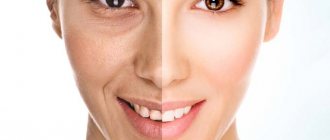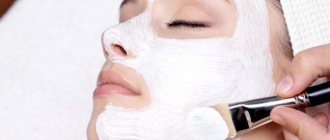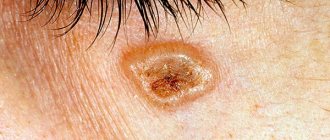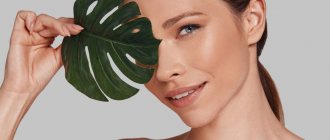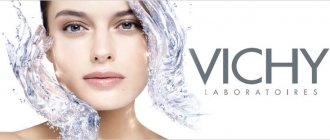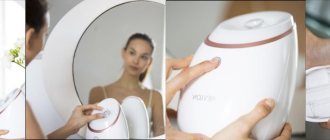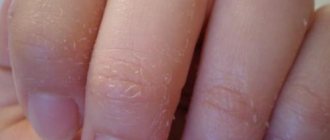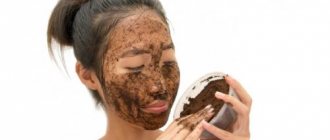Characteristics of dry skin type
Dry skin looks incredibly beautiful: smooth, with a peach tint, without greasy shine, eternal blackheads and enlarged pores.
But with age, it becomes thinner, the smallest capillaries and vessels are visible through it, and wrinkles on the forehead, in the corners of the eyes and near the lips can no longer be seen only when smiling.
In addition, the increased sensitivity of dry skin to external influences (precipitation, wind and polluted air) causes more and more discomfort with age.
What is the reason? The phenomenon of dryness is objectively characterized by impaired lipid and water metabolism, a slightly acidic pH reaction and impaired functioning of the sebaceous and sweat glands.
Dry skin is different:
- fine porous structure;
- lethargy;
- pallor (dull shade);
- dryness and flaking;
- feeling of tightness;
- frequent irritations.
| It’s easy to determine whether your skin is dry: to do this, press it with your fingers; if the marks do not disappear for a long time, then you have dry skin type. | |
Dry skin, unlike other types (oily, combination and normal), is less protected, because its sebaceous glands produce significantly less oil and practically no natural protective film is formed on it.
With age, this becomes more noticeable, since fat production decreases by the age of 20, and by the age of 30, such skin requires special care.
The structure of the epidermis. Keratinization.
TO
– keratinocyte,
M
– melanocyte (pigment cell),
L
– Langerhans cell (immune cell),
KM
– Merkel cell (tactile cell).
On the basement membrane between the basal keratinocytes there are cells responsible for the formation of pigment ( melanocytes
).
Immune cells are located slightly higher
responsible for recognizing foreign substances and microorganisms (
Langerhans cells
).
Obviously, agents that penetrate deeper than the stratum corneum will affect not only keratinocytes, but also cells of the immune system and pigment cells.
Another type of cells found in the epidermis, Merkel cells, are responsible for tactile sensitivity.
.
Dry skin care
Dry skin types must be carefully and promptly cared for, otherwise wrinkles will inevitably appear, which every woman is so afraid of.
This is not difficult to do, because on the shelves of pharmacies and stores there are enough products intended for dry skin. But it’s better to buy them after consulting a cosmetologist - don’t blindly trust advertising or the advice of friends .
Cosmetical tools
As a rule, cosmetologists recommend buying a full range of care products , since the medicinal properties of drugs from the same line enhance and complement the effects of each other.
Ideally, it is better to test trial samples on your skin, but if the cosmetics suit you, then purchase the entire series.
The effect of modern skin care products is not limited to a few hours, but appears throughout the day. If you use high-quality products regularly, their long-term effect is ensured.
Please note that if, after applying a moisturizer, you still want to apply a cream, then you should discard your moisturizer. Most likely, it does not contain enough fat and will be completely useless for you.
nanospheres , thalaspheres , ceramides and liposomes , which are designed to bind moisture in the skin, are perfect
Ceramides have proven themselves especially well; they perfectly compensate for the lack of natural lubrication between skin cells.
Creams that contain linolic (gamma-linolic) acid or sassanqua oil .
Skin types, condition and proper care for it
Just as you can tell the condition of the skin of the whole body by looking at the skin of your face, let’s look at its features in more detail. First, let's cleanse our face well of dirt and cosmetics. To do this, wash with soap. If after this there is a feeling of tightness on the face, the skin is dry and shiny, then it is dry.
If the skin is elastic, smooth, elastic - it is normal.
For the final determination, let your face rest for a couple of hours. And then blot certain areas of your face with a dry cloth. If the napkin becomes greasy, then the skin in this area is oily; if not, the skin is dry.
Rules for regular care
You need to take care of dry skin regularly, it must be constantly nourished, moisturized, and be sure to protect it from exposure to sunlight.
Clean it at least 2 times a day.
Morning
In the morning, use toilet milk , liquid cream or oil , then wipe the face with lotion and apply cream, the excess of which is removed with a paper napkin.
During the day
Dry skin types are cleansed with milk or cosmetic cream . After cleansing, apply a nourishing cream containing vitamins. For dry skin types, you should regularly make nourishing and moisturizing masks at least 2 times a week.
Evening
It is advisable to cleanse dry skin in the evening with a soft milk with nutrients. Then apply a night cream with moisturizing ingredients. You can additionally apply gel if your skin lacks moisture.
Proper care of dry skin ensures its magnificent and well-groomed appearance; the skin will not lose its beauty over time.
The skin on the face is thin. Features and Signs
The reasons why thin skin appears on the face are hereditary factors, significant loss of water in the body, or changes associated with age.
Age-related and hereditary causes cannot be corrected. Thin skin can be identified using the following signs:
- even color, light blush;
- no noticeable pores;
- highly susceptible to irritation;
- redness appears after touching the face;
- Vessels are visible in places;
- gets old quickly.
To properly care for thin skin, you need to know its features. It instantly reacts to any external irritants (temperature changes, frost, ultraviolet rays, salt water, etc.). There is an insufficient amount of melanin in the epidermal cells, so the tissues have pronounced pallor. In people with rich facial expressions, the appearance of the first wrinkles is observed even before reaching the age of thirty.
Thin skin tissues suffer greatly from poor lifestyle and bad habits. If you didn’t get enough sleep the night before, or allowed yourself an extra portion of alcoholic drink, swelling, redness and rashes will appear on your face. Smokers will quickly show signs of facial aging.
It is worth choosing decorative cosmetics very carefully and responsibly. After all, a face can respond to it with an unexpected reaction. You should not save money and buy cheap cosmetics of unknown origin. Thin skin is too sensitive; after such exposure, acne, peeling, and red spots may appear.
But there are also positive aspects to thin skin. Since the tissue structure is the same in the area around the eyes and on the surface of the face, you can purchase fewer cosmetics for care. There will be no oily shine, enlarged pores or blackheads on your face.
To determine if your skin is thin, you can do a simple test. Take a regular pen and rub the blunt end of it across your cheek, no pressure required. With normal skin, the reddened mark disappears in fifteen, maximum twenty, seconds. If the mark remains longer, your skin is very thin and needs special care.
Cleansing dry skin
Any cleansing preparations intended for dry skin should not remove natural oil from the skin, but contain moisturizing substances.
It is advisable not to use eau de toilette or any products containing alcohol .
Even ordinary water can cause inflammation and irritation, so it is advisable to use special lotions or melt water for washing .
If you don’t have melted water on hand, you can use plain water, adding a little soda to it, or wash your face with milk diluted with water.
To cleanse dry skin, use gentle lotions.
a soft lotion from rose petals yourself: pour three cups of dry petals with almond (peach) oil to cover the petals. Keep in a steam bath until the petals lose their color. This lotion can be used 2-3 times a day.
Water for washing in winter should be at room temperature, and cooler in summer.
Dry skin tolerates washing more easily if it is first lubricated with vegetable oil or fermented milk products (sour cream, kefir, yogurt). You can also lubricate dry skin with a rich cream or cream before washing (15 minutes before).
Decoctions (infusions) of medicinal herbs are also excellent for washing.
In the evening, it is better to cleanse dry skin not with water, but with a cleansing cream, herbal infusion or kefir.
Use soap as little as possible (both when washing and bathing). Using oatmeal you can perfectly wash dry skin, both face and body. Simply place oatmeal in a linen bag and use it as a washcloth. Oatmeal contains beneficial substances that nourish the skin and do not wash away its fat layer.
Layers of skin
Before directly examining the structure of the skin, we will highlight several important points from the point of view of cosmetic science:
- The skin consists of layers that differ both in their structure and purpose.
- The skin is constantly renewed. That is why it can really be improved and rejuvenated.
- In addition to creating appearance, leather has many important functions, so care must be taken to ensure that decorating efforts do not harm it.
- The skin is part of the body, so some of its problems simply cannot be solved in isolation.
- It is a living organ, but some of its structures are more dead than alive. This is the unique structure of the skin and the secret of its endurance.
Whether we are talking about the structure of the skin and its physiology, diseases, appearance, cosmetic care, etc., we should always remember that its main function is to differentiate the internal environment of the body from the external environment.
Layers of the skin: in dermatology, the skin is usually considered to consist of three main layers, each of which is divided into smaller layers:
1. Epidermis
2. Dermis
3. Subcutaneous fatty tissue.
a) Histological section of the skin on the inner side of the forearm.
b) Schematic representation of a skin section.
Stratum corneum
Formally, the stratum corneum of the skin is the uppermost part of the layer called the epidermis.
Layers of the epidermis:
- Horny
- Grainy
- Spiky
- Basal.
But in cosmetology, the stratum corneum is usually considered separately, since this is where the action of most cosmetic products is directed.
Stratum corneum
- this is the thinnest film on the surface of the skin that can be lifted with a needle and which forms a wall of blisters during a burn. If you put it under a microscope, you can see many translucent scales (horny scales or corneocytes), which are built from a special protein - keratin.
Horny scales were once living cells, but during development they lost their nucleus and cellular organelles. From the moment a cell loses its nucleus, it formally becomes dead.
The main job of these dead cells is to protect what is underneath them. In other layers, they perform the same role as the scales of lizards. Except they look less impressive.
Horny scales fit tightly to each other, connected by special outgrowths on the shell. And the entire space between the layers of horny scales is filled with a substance that is a mixture of lipids (fats).
The chemical composition of intercellular lipids is a mixture:
- Ceramides
- Free sphingoid bases
- Glycasilceramides
- Cholesterol
- Cholesterol sulfate
- Fatty acids
- Phospholipids, etc.
This intercellular substance, the layers of skin, performs the same role as cement in brickwork.
Having water-repellent properties, the intercellular substance of the stratum corneum does not allow water and water-soluble substances to enter the skin, as well as prevents excessive loss of water from deep in the skin.
It is thanks to the stratum corneum that the skin is a reliable barrier that protects us from the external environment and foreign substances
.
Note that the substances included in cosmetic products are foreign to the skin, since they do not belong to the body. Fulfilling its main task - to protect the body from any external influences, the skin is in no hurry to “recognize the stranger” and tries to prevent cosmetic components from penetrating inside.
Some cosmetics can destroy or weaken the protective layer of the skin, and then it will begin to lose moisture, and its sensitivity to environmental factors will increase.
No matter how strong the scales are and no matter how well the “cement” holds them together, the tests to which the skin is exposed every day are so great that the stratum corneum wears out very quickly (just like clothing wears out).
The way out that nature found from this situation suggests itself - if the clothes are worn out, they need to be changed. Therefore, worn-out horny scales fly off the surface of the skin and turn into ordinary household dust, which accumulates on the lower shelves and under sofas (of course, not only our skin contributes to the formation of dust, but the contribution of the skin is very large).
Stratum corneum
- this is what we see when we look at the skin, and it is also the main area for the influence of cosmetic products. However, its formation begins deep in the epidermis, and it is there that processes occur that affect its appearance.
By acting externally, we can decorate the stratum corneum, improve the properties of the surface (make it smoother and more flexible), and also protect it from damage. And yet, if we want to significantly change its structure, the impact must begin within.
Toning dry skin
One of the most important stages of caring for any skin is toning.
Many women are sure that it is enough to cleanse their face and that using toner is not necessary, but this is not true.
Using a toner improves blood microcirculation, thereby preparing the skin for the application of cosmetics and greatly improving their effect (by almost a third).
To ensure that cleansers and toners complement each other, use the same cosmetic line.
Tonics intended for dry skin should not contain alcohol, and they should contain a sufficient amount of moisturizing and softening components.
To tone, you can use rose water or glycerin lotion - they perfectly moisturize and cleanse. Nettle juice gently tones aging dry skin.
Well-toned products that include:
- algae extracts;
- silk and wheat proteins;
- wheat germ extract;
- vitamins;
- marine collagen.
Skin layers:
1. Epidermal layer, which is responsible for protective functions.
2. The dermal layer is responsible for the firmness and elasticity of the skin.
3. Subcutaneous fat, which acts as a reserve of nutrients, protects from mechanical stress and preserves the skin of the face.
Layers of the skin: epridermis
This is the thinnest part of the skin layer (no thicker than 2 mm); it consists of 5 layers, the uppermost of which is formed by flat cells. The life cycle of such a cell begins in the very depths of the epidermis in the basal layer and ends in the outer stratum corneum, passing through the spinous and granular layers; this is the metabolism of the skin.
When its function is not interfered with by aggressive environmental factors, internal diseases, improper use of cosmetics and other negative factors, the skin of the face is actively renewed.
The epidermis of thick skin consists of five layers:
- basal
- spiny
- grainy
- brilliant
- horny.
In thin skin there is no shiny layer.
Epithelial cells of the epidermis (keratinocytes) are continuously formed in the basal layer and are displaced to the overlying layers, undergoing differentiation and ultimately turning into horny scales and sloughing off the surface of the skin.
The basal layers of the skin are formed by one row of cubic or prismatic basophilic cells lying on the basement membrane, with well-developed organelles, numerous keratin filaments and tonofilaments. These cells play the role of cambial elements of the epithelium (among them there are stem cells and mitotic figures are found) and provide a strong connection between the epidermis and the dermis (connected with neighboring cells by desmosomes, and with the basal membrane - by hemidesmosomes).
The spinous layers of the skin consist of several rows of large irregularly shaped cells connected to each other by desmosomes in the area of numerous processes (“spikes”) that contain bundles of tonofilaments. Organelles are well developed. Dividing cells are found in the deep sections.
The granular layers of the skin are thin , formed by several rows of flattened (spindle-shaped when cut) cells.
The shiny layer of skin (available only in thick skin) is light, homogeneous, and contains the protein eleidin. Consists of 1-2 rows of flattened oxyphilic cells with undetectable boundaries. The organelles and nucleus disappear, the keratohyaline granules dissolve, forming a matrix into which the tonofilaments are immersed.
The stratum corneum is formed by flat horny scales that do not contain a nucleus or organelles and are filled with tonofilaments lying in a dense matrix. Their plasmalemma is thickened due to the deposition of proteins (mainly involucrin) on the inner surface. The scales have high mechanical strength and resistance to chemicals. In the outer parts of the layer, desmosomes are destroyed and horny scales are peeled off from the surface of the epithelium.
Regeneration (renewal) of the epidermis ensures its barrier function due to the constant replacement and removal of outer layers that are damaged and contain microorganisms on their surface.
The renewal period is 20-90 days (depending on the area of the body and age), it is sharply reduced when the skin is exposed to irritating factors and in some diseases (for example, psoriasis).
As cells move towards the surface of the skin, they lose moisture, fill with horny substance - keratin and become flat.
When we lead a healthy lifestyle and take proper care of our skin, the outer layer should be completely renewed in less than a month (28 days).
The skin of the face has a smooth surface and a healthy appearance. But there are many reasons that complicate this process of skin renewal. For example, the separation of horny scales slows down with age (by one day for each year lived).
- At the age of 18, this process occurs in 28 days, and each year lived adds one day.
For example. If you are 50 years old, this process will take you 60 days (28 days + 32 days). What does it mean? This means that, as a percentage, there are more old cells than young ones. This leads to an increase in the stratum corneum, and, consequently, to skin aging. But the thickness of the stratum corneum is also affected by exposure to sunlight, as this forms a kind of barrier (skin protection) against the rays.
Masks for dry skin
For dry skin types, it is advisable to make masks that smooth its surface, making it elastic, smooth and beautiful. You can buy them ready-made or make them yourself. Natural masks perfectly nourish and moisturize the skin, supply it with vitamins. Natural fats (vegetable oil, sour cream, cream, etc.) must be present in such masks.
Apple mask
Apples have an excellent moisturizing effect; to make a mask out of them, grate 1 apple and apply the resulting mixture to your face for 15 minutes. Afterwards, rinse off the mask and rinse your face with cool water.
Potato-curd mask
With the help of such a mask it is easy to restore the skin's water balance. Boil a medium potato in its jacket, peel it and mash it with a fork. Add 1 tbsp to the resulting puree. a spoonful of cottage cheese and olive or vegetable oil and 1 teaspoon of glycerin. Mix the mixture thoroughly. Apply a warm mask for 20 minutes; if it does not stick well to your face, then place gauze on top. Remove the mask with warm water, and rinse your face with cool water.
Aloe juice mask
1 tbsp. a spoonful of aloe juice is mixed with 2 tbsp. spoons of warmed honey and apply for 15 minutes. This mask quickly improves complexion, because it stimulates natural processes in the skin (blood flow, metabolism, formation of new cells).
Oatmeal mask with yolk
Pour some rolled oats into boiling milk, do not cook. The consistency of the mask can be anything, but it is better if it is thick. After cooling the mass, add 1 teaspoon of vegetable or olive oil and one yolk, which must be beaten well. Mix everything and the mask is ready.
Yeast mask
Mash the package of compressed yeast and pour milk over it to obtain the consistency of thick sour cream. The mass is applied to the face in a dense layer, washed off after 15–20 minutes with warm water. Yeast contains many B vitamins, which are essential for our skin.
Flaxseed mask
2 tbsp. Boil spoons of flaxseed in 2 glasses of water. The finished porridge is applied warm to the face for 20 minutes. This mask will help restore dry skin that is irritated by wind and cold.
Dermal layers of skin
The dermal layer is located directly below the epidermis. This layer consists of two types of fibers, one of which consists of:
• The proteins are collagen and the other is elastin. papillary layer - forms conical protrusions (papillae) protruding into the epidermis, consists of loose fibrous connective tissue with lymphatic and blood capillaries, nerve fibers and endings.
Provides connection between the dermis and the basement membrane of the epidermis with the help of reticular, elastic fibers and special anchor fibrils.
• reticular layer - a deeper, thicker, stronger layer that is formed by dense fibrous unformed connective tissue and contains a three-dimensional network of thick bundles of collagen fibers interacting with a network of elastic fibers.
Subcutaneous tissue (hypodermis) plays the role of a heat insulator, a kind of depot of nutrients, vitamins and hormones, and ensures the mobility of the skin layer. Formed by lobules of adipose tissue with layers of loose fibrous tissue; its thickness is related to our diet and body area, and the general nature of its distribution in the body is determined by the influence of sex hormones.
Any disturbances in this layer, and in particular: with increasing age, breaks in these fibers appear, cellular tone decreases, elasticity is lost, wrinkles form and pores expand, and the elasticity of the skin is lost.
As a figurative and visual example, let’s take a sofa, which is in every home. While it is new, it is elastic, its surface is smooth. Over time, the springs weaken and deformations of the surface of the sofa are already visible, the same thing happens to our skin.
Subcutaneous fat
The deepest layer, subcutaneous fat, consists of connective tissue, the loops of which are filled with fatty lobes. The thickness of this layer is not the same in different parts of the body; as for the face, this layer is very small here; it is completely absent on the eyelids.
- Sweat glands are involved in thermoregulation, as well as in the excretion of metabolic products, salts, drugs, heavy metals (increased with renal failure).
- The sebaceous glands produce a mixture of lipids - sebum, which coats the surface of the skin, softening it and enhancing its barrier and antimicrobial properties.
They are present everywhere in the skin, with the exception of the palms, soles and dorsum of the feet. Usually associated with hair follicles, they finally develop in adolescence during puberty under the influence of androgens (in both sexes). The secretion of the sebaceous glands (20 grams per day) occurs during contraction of the muscle that lifts the hair (formed by smooth muscle cells and passes from the papillary layer of the dermis to the hair follicle). Overproduction of sebum is characteristic of a disease called seborrhea.
One of the skin problems is AGING
Signs of skin aging are the appearance of barely noticeable wrinkles when the elasticity of the skin is impaired. The skin loses its elasticity and becomes porous. By changing its structure, the skin loses its smoothness, healthy shine and moisture. Slow metabolism gives the face a sallow, dull color; age spots also do not decorate the face.
Causes of skin aging:
1. Decrease in the total number of new cells, cellular energy imbalance. 2. Extending the metabolic cycle of skin cells
All these causes of aging are influenced by internal factors:
- Age
- Genes
- Wrong lifestyle
- Aggressive (harmful) environmental factors)
- Incorrect use of cosmetics
- Expired cosmetics
External factors include:
- Insufficient supply of nutrients and fluids.
- Lack of proper care.
- Environmental pollution, UV radiation
- Intense pace and disrupted natural rhythm of life.
Uncontrollable skin condition factors:
- Heredity
- Age
- Humidity
- Sun exposure
- Temperature
- Wind
- Environmental pollution
Controlled factors:
- Positive attitude
- Healthy lifestyle
- Regular use of products recommended specifically for your skin type.
Scientists have proven that the secret of preserving youth lies in a gene called gandoderm. Ganoderma (lat. Ganoderma lucidum, Reishi or Lingzhi mushroom)) is a genus of tinder fungi from the Ganodermataceae family.
Moisturizing cosmetics for dry skin
Dry skin type requires mandatory nutrition and protection. Therefore, before a walk, it is better to use a moisturizer, which must be applied for 10–15 minutes, and then remove its excess.
For dry skin, use a nourishing moisturizing day cream .
When choosing it, pay attention to the consistency: if the cream is light and resembles milk, then most likely it will not be fat enough.
Apply day cream after washing, and then after 5 minutes additionally lubricate the driest areas of the face.
Be sure to use a night cream; if you have dry skin, you should not use the same product both morning and evening. Night creams contain fats that promote skin cell renewal, so using them is a must.
Ganoderma lucidum: a treasure for the skin
It is this higher mushroom that suppresses the work of the gene responsible for aging, stimulating the activity and growth of skin cells, restores the structure of the skin and brings it into ideal condition, and promotes weight loss.
In addition, it is a source of health and beauty of the skin, as it deeply moisturizes it and improves the synthesis of macromolecular proteins that ensure its elasticity.
Thanks to the discovery of epidermal growth factor, the mysteries of aging and biological changes in the body were unraveled.
- From the age of 21-25, the first shallow wrinkles begin to appear on the face. 75% of women over the age of 36 had fairly deep wrinkles;
- at the age of 18-40, small pigment spots appear on the face; after 30 years their diameter can exceed 6 mm. 60% of women aged 26-60 years have age spots.
Ganolerma is the first step towards realizing the cherished dream of all humanity - to stop the aging process and restore youth to aging skin.
That's why Ganoderma is called the beauty factor.
Thin skin under the eyes. Cosmetics
For thin and sensitive facial skin, look for products marked “Sensitive”
To care for such problematic, dried out epidermis, you need specially developed cosmetics. It perfectly moisturizes, restores firmness and elasticity, and protects against external aggression.
There is another way out - to purchase and use creams and serums for the face, which are required by the thin skin around the eyes, which is also devoid of fat and needs special, more careful treatment.
So buy products labeled “sensitive” or “for eyes”.
The approximate rating will help you choose something suitable for your budget:
- Bioregene crème peaux sensibles. Methode Cholley. Switzerland;
- Super Sensitive Shield (Ultra Calming line). Dermalogica. USA;
- 24-hour Care for sensitive. Biodroga. Germany;
- Delicate Care Recovery Cream. Otome. Japan;
- Idrasensitive 24-hour Cream. Eldan. Switzerland;
- Bio Phyto Skin Balance. Christina. Israel;
- Redermic C. La Roche-Posay. France;
- Wildrose. Weleda. Germany;
- Cream for sensitive skin. Bark. Russia;
- Anti-Wrinkle. Olay. USA.
All these cosmetic creams can be used not only for thin facial skin, but also for the equally sensitive and defenseless epidermis around the eyes. A magical transformation becomes possible thanks to the unique composition of such cosmetics. As a rule, it contains the following active substances:
- allantoin soothes irritations and restores damaged epidermis;
- hyaluronic acid moisturizes, heals;
- almond oil, myrrh, jojoba create a barrier film from aggressive external factors;
- retinol moisturizes, restores, prevents dryness;
- ascorbic acid heals, protects, strengthens, and maintains the fat (lipid) layer in a normal state;
- tocopherol gives elasticity, tones, rejuvenates;
- plant extracts have a healing effect.
Even the very thin skin under the eyes and the most sensitive epidermis of the face are transformed under the influence of properly selected cosmetics. The rays of facial wrinkles become less noticeable. The pallor recedes and a blush appears on the cheeks. Abundant hydration prevents dryness and flaking.
But if all these remedies cause a negative reaction in the form of a skin rash, irritation, hyperemia, etc., you will have to use folk remedies to care for thin and sensitive facial skin.
Additional Information. Luxury cosmetics include the American brand Dermalogica, which is distinguished not only by its high prices for its products, but also by its therapeutic functions. The Ultra Calming line was developed specifically for thin, sensitive epidermis that needs additional protection and care.
Preventing dry skin
To maintain dry facial skin in good condition, you need to start caring for it at a young age. It is also necessary to strengthen the general condition of the body, follow simple recommendations, and then many problems associated with dry skin can be avoided.
Here are the basic recommendations for reducing dry skin:
- To moisturize dry skin, drink at least 1.5 liters of clean water throughout the day.
- Wash your face with water at room temperature.
- Use mild products to wash your face that do not dry out your skin.
- Do not use cosmetics containing alcohol.
- Take a vitamin complex containing vitamins A, C, E, D, F, as well as fish oil.
- Use humidifiers.
- Use special moisturizing masks several times a week to moisturize your skin.
- Avoid pools with chlorinated water.
- In the summer, before going out into the sun, use special creams with protection from ultraviolet rays.
Summary:
Previously, in the 90s of the last century, four skin types were known: dry, oily, normal and combination. Currently, these categories are no longer sufficient to fully characterize the skin and select products for skin care and treatment. A large selection of modern products for skin care and treatment makes it difficult to choose the right product. Based on this, there is a need to develop a thorough description and complete characterization of the skin, which would allow the selection and use of appropriate cosmetic and therapeutic products. A newer approach for skin type classification is the recently developed Baumann Skin Type Indicator (BTI). It is a questionnaire of 64 questions to determine and establish a specific skin type: dry or oily skin, sensitive or resistant, pigmented or non-pigmented, with or without wrinkles. The skin assessment is based on these four main characteristics and identifies 16 potential skin types. For example, a patient with dry, sensitive, pigmented and wrinkled skin needs completely different medications than a patient with oily, resistant, non-pigmented and non-wrinkled skin. This article describes in detail the main four characteristics of skin, which are summarized into 16 skin type options. Of course, skin types are not stable; moving to a different climate, stress, pregnancy, menopause or other life situations can significantly change your skin type. Approaches to topical therapy and care for different skin types depending on the BICT type are also described.
Table. Baumann Skin Type Indicator (BIST)
| Fat | Dry | ||||
| Pigmented | Not pigmented | Pigmented | Not pigmented | ||
| Wrinkles | OSPW | OSNW | DSPW | DSNW | Sensitive |
| Fit | OSPT | OSNT | DSPT | DSNT | Sensitive |
| Wrinkles | ORPW | ORNW | DRPW | DRNW | Resistant |
| Fit | ORPT | ORNT | DRPT | DRNT | Resistant |
Abbreviations: D, dry; N, not pigmented; O, fatty; P, pigmented; R, resistant; S, sensitive; T, smooth; W, wrinkled
SKIN HYDRATION
Oily skin versus dry skin
Dry skin always causes more problems than oily skin. Dry skin, also called xerosis, is the result of a combination of several factors. But the characteristics of dry skin are common to all varieties: dull color (usually light gray), rough texture and uneven surface. The level of stratum corneum lipids, sebum, natural moisturizing factor and aquaporin are the main most important factors that regulate the degree and severity of dry or oily skin. Although the skin's barrier function is independent of sebum levels, sebum still contributes to the development of xerosis. The skin's production of sebum depends largely on age: sebum levels are usually very low in childhood, rise during early adolescence, and remain relatively stable for about 10 years, beginning to decline by age 18, after which its production gradually declines.
Skin care taking into account oily-dryness:
Whether there are acne lesions on the skin or not, this primarily depends on the severity of the oily skin. The BITC coefficient for oily skin with acne is characterized as OS (oily-sensitive), since acne-affected skin is markedly sensitive. For these patients, therapy should focus on reducing sebum levels - Retinoids, removing or reducing skin bacterial loads with antibiotics, benzoyl peroxide or other antimicrobials, and anti-inflammatory therapy. Treatment of oily skin without acne - skin type OR, oily resistant (BITC index) should be aimed at reducing the level of sebum secretion, and also, if present, at factors such as dyspigmentation and wrinkles (see below). Sebum secretion is effectively reduced with oral ketoconazole and oral retinoids; similar effectiveness has not yet been proven with topical medications. The oiliness of such skin can be masked by using sebum-absorbing polymers and talc. Absorbents, when used in cosmetic products, dissolve fats, cover the stratum corneum of the skin and reduce transdermal fluid loss (TFL). In addition to suppressing TPV, absorbents play the role of emulsants and are thus also suitable products for the treatment of xerosis. The best known of this group of drugs are Petrolatum and mineral oil. Also often used as active ingredients are paraffin, squalene, silicone derivatives (dimethicone, cyclomethicone), soybean oil, propylene glycol, lanolin, lecithin. Propylene glycol is an odorless liquid with antimicrobial and keratolytic properties, acting as an absorbent and humectant. Propylene glycol has been shown to facilitate the entry of certain drugs into cells, including steroids and minoxidil. Acne skin type is widespread, most often occurring in adolescents and young adults, equally in men and women from 11 to 25 years old. The second group that often suffers from acne is adult women with hormonal imbalances. The pathogenesis of this stressful and disfiguring condition involves 4 main factors: increased sebum production, clogged pores with dead keratinocytes inside the hair follicles, bacterial growth (R. Acne) and inflammation. The inflammatory component leads to characteristic local redness and swelling. High levels of primary cytokines, chemokines and other inflammatory markers are commonly found in acne. Acne therapy targets all 4 etiological factors: reducing sebum production (retinoids, oral contraceptives), pore blockage (retinoids), removing the bacterial component (antibiotics, azezaic acid, benzoyl peroxide), reducing inflammation (retinoids). According to the National Rosacea Society of the USA, about 14 million Americans suffer from rosacea skin type, 66% of them are adults from 25 to 60 years old. The pathophysiology of this acneiform condition has not yet been fully established; the symptoms are similar to acne, accompanied by specific facial redness, hot flashes, and papules. In addition, rosacea is characterized by the formation of large telangiectasia. Topical therapy for rosacea consists of the use of anti-inflammatory components to narrow dilated blood vessels. The main goals of rosacea therapy are to reduce vascular reactivity, the influence of free radicals or reactive oxygen molecules, inhibition of the immune response, reduction of eosinophilic activity, mast cell degranulation and interruption of the arachidonic acid cycle. The most effective anti-inflammatory components (many derived from plants) in topical treatment for rosacea include aloe aera, arnica, chamomile, niacinamide, salicylic acid, sulfur, zinc. In addition, antibiotics, immunomodulators and steroids are used.
Skin pigmentation
Pigmented versus non-pigmented skin
The skin pigment melanin is formed as a result of the enzymatic breakdown of tyrosine. There are two types of melanin – eumelanin and pheomelanin. The most common type, eumelanin. More melanin is formed in dark skin compared to light skin. Large melanosomes in people with dark skin accumulate more melanin, and thus disintegrate more slowly, compared to melanosomes in light skin. Melanin is synthesized in melanocytes and then passes as melanosomes into keratinocytes. UV irradiation also stimulates melanogenesis, but at the same time, the formation of melanin is a protective reaction of the skin to UV irradiation. The development of skin pigmentation can be inhibited in two different ways - by inhibiting tyrosinase, thereby preventing the formation of melanin; and preventing the transition of melanin to keratinocytes. Effective tyrosinase inhibitors are hydroquinone, kojic acid, arbutin, and licorice extract. Two proteins isolated from soy, soy trypsin inhibitor and Bowman-Birk inhibitor, have been shown to prevent the transfer of melanin to keratinocytes. These substances have also been shown to prevent the development of skin pigmentation in vitro and in vivo. A similar effect, that is, preventing the transition of melanin to keratinocytes, was found in niacinamide, a derivative of vitamin B3. Also in the treatment of age spots, exfoliating drugs such as retinoids and acids are used; they accelerate the process of cell growth, so that the stage of melanogenesis is skipped.
Skin aging
Wrinkled and non-wrinkled skin
Skin aging is a dynamic, multifactorial process that is regulated by the influence of endogenous and exogenous factors. Etiological factors are traditionally considered as two separate processes: internal - genetic determination or cellular programming, an inevitable process that gradually leads to visible skin damage; and external factors - also manifest as skin lesions, develop as a result of chronic exposure to various environmental factors, and are also inevitable, although preventable. Recent studies have shown that the main primary factor causing exogenous skin aging, UV irradiation, can also influence and alter the normal course of natural aging. Recently, the function of telomeres, special structures that are located at the ends of chromosomes, has been carefully studied and shown to be a key factor in intrinsic aging. Telomere length shortens with age, and this shortening is the internal aging clock for every organism. The enzyme telomerase stabilizes or lengthens the length of telomeres; its amount decreases significantly with age. Currently, there are no therapeutic options to influence telomerase, since there is insufficient data on the safety of influencing telomere length. External factors of aging - can be prevented as a result of lifestyle, these include primarily smoking, air pollution, poor diet, alcohol consumption and, most notably, sun exposure.
Rhytid formation, which begins in the lower layers of the dermis, is a major manifestation of skin aging. Very few skin products can penetrate deep enough into the dermis to stop or slow down the formation of deep wrinkles, despite advertising and manufacturer claims. Anti-aging skin medications focus on preventing the formation of wrinkles. It is well known that levels of three key components of the skin - collagen, elastin and hyaluronic acid - decline with age, so the primary goal of therapy is to prevent one or more of these key components. Although there are no topicals yet that can penetrate deep into the epidermis, certain products can enhance the production of these key skin components. Topical retinoids, vitamin C, and copper peptide have been shown to stimulate collagen production. Taking vitamin C orally has a similar effect. In addition, retinoids are known to increase the synthesis of hyaluronic acid and elastin in animal models, while the addition of glucosamine also increases hyaluronic acid levels. There are still no recommended drugs to stimulate elastin production. The main recommendations regarding the external factors of aging are to avoid sun exposure, use broad-spectrum sunscreens, stop smoking and avoid air pollution, take oral antioxidants, regularly use topical retinoids, and eat a diet rich in fruits and vegetables. The Skin Type Indicator can help each person individually understand their skin type, navigate the choice of care products for this skin and apply the most appropriate therapy. For example, individuals with oily, sensitive, non-pigmented and wrinkled skin (OSNW skin type) may benefit from retinoids and antioxidants. And for people with dry, sensitive, non-pigmented, wrinkle-free skin (DSNT type) it is better to use drugs that restore the skin barrier. Armed with knowledge of a patient's skin type, physicians will have meaningful information to guide them in selecting treatments for multiple skin lesions and choosing the right treatment from the numerous treatments available on the market.

